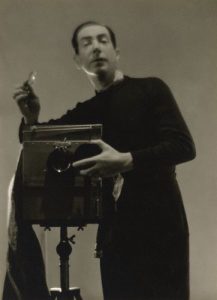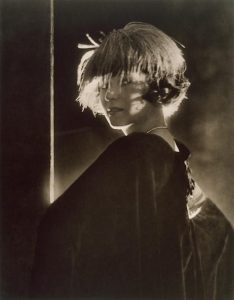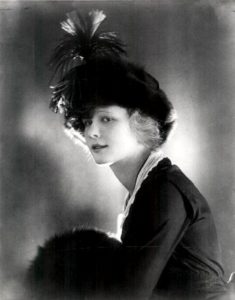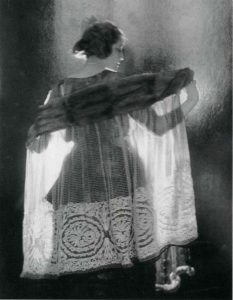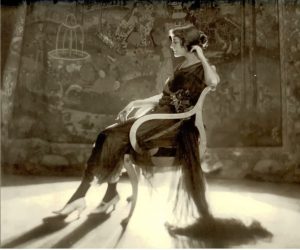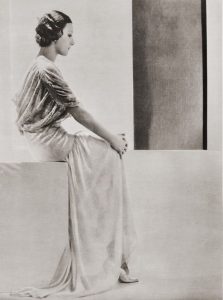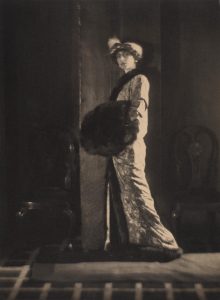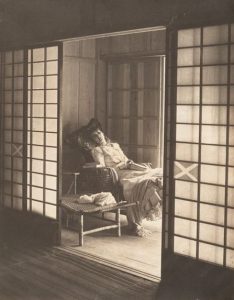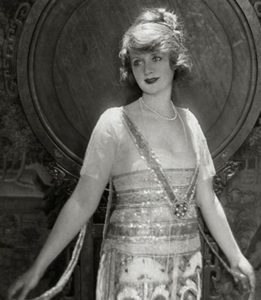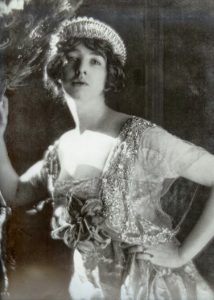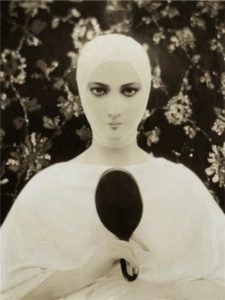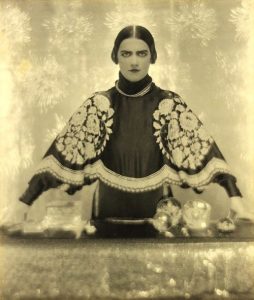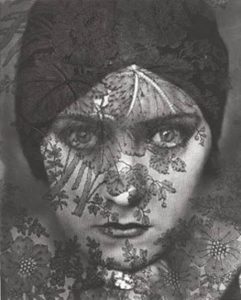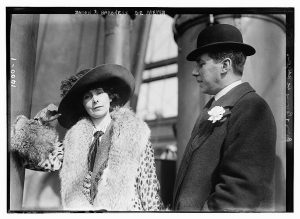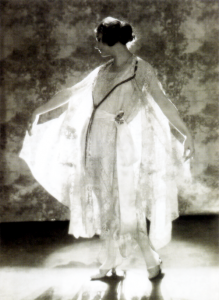Blog 88 17/10/2019 Debussy of the Camera: Fashion Photographer Baron Adolph de Meyer
Debussy of the Camera
Fashion Photographer Baron Adolph de Meyer
Baron Adolph de Meyer (1868 – 1946) was an innovative fin-de-siècle artist, considered today as the founder of fashion photography, paving the way for many contemporary fashion photographers such as Helmut Newton and Richard Avedon. De Meyer was also the preeminent photographer of Vaslav Nijinsky and the Ballets Russes, and a dedicated and skilled pioneer in the use of the autochrome process of colour photography. He was not merely a fashion photographer, he also mingled in the upper echelons of society and through his sophisticated portraits, captured an elegant and leisure-filled world which vanished with the outbreak of WWII. Some of his famous portraits are of Mary Pickford, Rita Lydig, Luisa Casatii, Billie Burke, John Barrymore, Lillian Gish, Ruth St. Denis, King George V and Queen Mary, and Josephine Baker, to name just a few.
De Meyer’s own life reads like something from the gossip columns. Born in Paris and educated in Dresden, Adolphus Meyer was the son of a German Jewish father and Scottish mother—Adolphus Louis Meyer and his wife, the former Adele Watson. In 1893, he joined the Royal Photographic Society and moved to London in 1895. In editions dating from 1898 until 1913, Whitaker’s Peerage stated that de Meyer’s title had been granted in 1897 by Frederick Augustus III of Saxony. Another source states that the photographer inherited it from his grandfather in the 1890s. Other sources say that this nobility is merely a creation, which would not be hard to believe as he certainly moulded his image to suit the circumstances. At various times in his life, he used the surnames Meyer, von Meyer, de Meyer, de Meyer-Watson, and Meyer-Watson. It was after 1897, that he was known as Baron Adolph Edward Sigismond de Meyer, though some contemporary sources list him as Baron Adolph von Meyer and Baron Adolph de Meyer-Watson. Quite a lot to get your head around, yet in those days, especially among the more bohemian and artistic, upper-class circles, people certainly changed their names and styles to suit the moment.
De Meyer married a woman with an equally mysterious past in 1899. Donna Maria Beatrice Olga Alberta Caracciolo was married to an Italian prince when they met. Olga’s birth records stated that she was the daughter of a Neapolitan nobleman, although everyone thought King Edward VII was her father. Whatever the truth is, she did grow up in a house called Villa Olga in Dieppe, France, paid for by the king. Olga’s pastimes included being a fencing champion, a muse, an artists’ model, and an author, which by all accounts was probably the least successful of her ventures. The New York Times panned her autobiography, called Nadine Narska as “morbid, exaggerated . . . and guilty of many carelessly written sentences.” One of her short stories, Clothes and Treachery, was made into a silent movie, The Devil’s Pass Keyin 1919 by director Erich von Stroheim.
Following the penchant for redesigning oneself, in 1916, on the advice of an astrologer, Olga changed her name to Mahrah. Not to be outdone, Adolph changed his to Gayne. Astrology seemed to play quite a role in both their lives.
Olga was the subject of many of her husband’s photographs. The de Meyers’ marriage was one of convenience rather than romantic love, since the groom was homosexual and the bride was bisexual or lesbian, yet they were rarely apart and apparently adored one another, but not in a sexual way. De Meyer wrote “Marriage based too much on love and unrestrained passion has rarely a chance to be lasting, whilst perfect understanding and companionship, on the contrary, generally make the most durable union.” The tenderness shown in de Meyer’s photographs of Olga attested to his devotion.
The de Meyers were definitely international jet-setters. Beautiful, stylish, talented, witty, and eccentric, they were the toast of the social set and Olga was painted by eminant artists of the day such as Giovanni Boldini, Walter Sickert, John Singer Sargent, Charles Conder and Paul César Helleu. The couple made their home in London’s Cadogan Gardens, Paris, and New York, and spent summers in Venice and Constantinople, winters in St. Moritz, and visited Greece, Spain, Morocco, Tangiers, Egypt, Hong Kong and Japan.
Japan had a profound influence on de Meyer’s work. He was also an art collector and one of the first owners of a Claude Monet series of painting, featuring the Houses of Parliament, as well as other Impressionist works.
In 1916, on the advice of the astrologer, and possibly because de Meyer was half Jewish and homosexual during a time of rampant homophobia and anti-Semitism, the couple moved to New York, where he became a photographer for Vogue from 1913–21, and for Vanity Fair. In 1922 de Meyer accepted an offer to become the Harper’s Bazaar chief photographer in Paris, becomimg the preeminent fashion photographer of the day. It was during his magazine years that he associated with, and photographed the smart set of the upper echelons of society.
His photography captured reality and distilled it into something fanciful, and his use of dramatic lighting, of a male model, and of two or more models in the same picture, was ground-breaking. He was a great manipulator of light and shadow, often veiling his lens in gauze. He used backlighting and added light in unexpected places. His influences included the Impressionists, Klimt and Watts, as well as Whistler.
De Meyer was known for his elegance and showy personal style. For a time he dyed his hair blue and drove a car to match it. Eventually his artistic and flamboyant career deteriorated as younger photographers began to make a mark, moving away from the soft-focus lens. His work was seen as outmoded by the 1930s, and he was forced to leave Harper’s Bazaar in 1932. Unrest in Europe brought him back to the United States in 1939,
As their bright life began to fade into obscurity, de Meyer and Olga became increasingly dependent on cocaine and opium. After Olga died, de Meyer destroyed much of his work and spent the time with his lover – a young German, Ernest Frohlich (born 1914) – whom he hired as his chauffeur and later adopted as his son. He died in 1946 in Hollywood, virtually penniless, unknown and unappreciated. After his death, Ernst took on the title and went by the name Baron Ernest Frohlich de Meyer
In his heyday, de Meyer definitely set a standard for elegance and style. British photographer and designer, Cecil Beaton called him the “Debussy of the Camera,” adding that he “had not been placed high enough in the hierarchy of photographers.”
COMING SOON
NEW RELEASE
The Poseidon Network
From USA TODAY Bestselling author, Kathryn Gauci, comes a mesmerising, emotional espionage thriller that no fan of WWII fiction will want to miss.
“One never knows where fate will take us. Cairo taught me that. Expect the unexpected. Little did I realise when I left London that I would walk out of one nightmare into another.”
- SOE agent Larry Hadley leaves Cairo for German and Italian occupied Greece. His mission is to liaise with the Poseidon network under the leadership of the White Rose.
Before long before he finds himself involved with a beautiful and intriguing woman whose past is shrouded in mystery.
In a country where hardship, destruction and political instability threaten to split the Resistance, and terror and moral ambiguity live side by side, Larry’s instincts tell him something is wrong.
After the devastating massacre in a small mountain village by the Wehrmacht, combined with new intelligence concerning the escape networks, he is forced to confront the likelihood of a traitor in their midst. But who is it?
Time is running out and he must act before the network is blown. The stakes are high.
From the shadowy souks and cocktail parties of Cairo’s elite to the mountains of Greece, Athens, the Aegean Islands, and Turkey, The Poseidon Network, is an unforgettable cat-and-mouse portrait of wartime that you will not want to put down.

